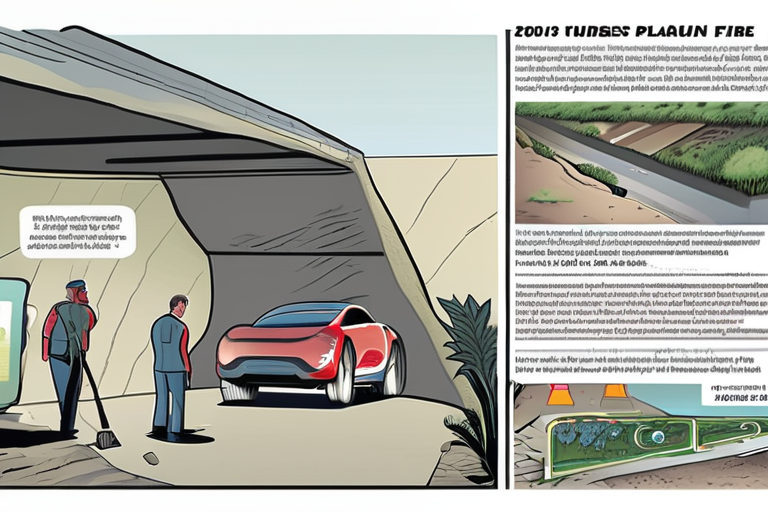The Tunnel Vision: Elon Musk's Ambitious Plan to Save Houston from Floods
As the sun set over the Houston skyline, a sense of unease settled over the city. The skies were darkening, and the air was thick with anticipation. It was a familiar feeling for residents of this Gulf Coast metropolis, where the threat of flooding looms large every time it rains. But on this particular evening, there was a glimmer of hope. Elon Musk, the billionaire entrepreneur behind SpaceX and Tesla, had unveiled a plan to build an extensive network of tunnels beneath Houston's streets. The idea was simple yet audacious: by digging deep into the earth, Musk claimed that his company, The Boring Co., could mitigate the city's chronic flooding woes.
The proposal, which has been months in the making, has generated both excitement and skepticism among experts and residents alike. While some see it as a game-changer for a city plagued by floods, others are raising red flags about its feasibility. As we dug deeper into Musk's plan, our investigation uncovered key technical and logistical challenges that have left many wondering if this tunnel vision is more hype than substance.
A Brief History of Flooding in Houston
To understand the context behind Musk's proposal, it's essential to grasp the city's complex relationship with water. Located on a low-lying plain near the Gulf of Mexico, Houston has long been vulnerable to flooding. The 2017 Tax Day flood, which inundated thousands of homes and businesses, was a stark reminder of this reality. Since then, the city has invested heavily in flood-control measures, including the construction of new levees and stormwater management systems.
But despite these efforts, flooding remains a persistent problem. In recent years, Houston has experienced several major floods, each causing millions of dollars in damage and displacing thousands of residents. It's against this backdrop that Musk's tunnel plan was born.
The Boring Co.'s Proposal
Musk's company, The Boring Co., has been lobbying elected officials to allow it to build tunnels under Houston for flood mitigation. The proposed system would involve digging two 12-foot-wide tunnels, stretching over 20 miles beneath the city's streets. Water from flooded areas would be pumped into these underground channels, where it would be stored and slowly released back into the environment.
The idea is based on a technology called "pressure equalization," which involves using pumps to maintain a stable water level within the tunnels. This approach has been used successfully in other parts of the world, including Singapore and Hong Kong. However, experts say that Houston's unique geology and hydrology pose significant challenges for this type of system.
Experts Weigh In
We spoke with several experts who have reviewed Musk's proposal, and their concerns are stark. "The biggest issue is the sheer scale of the project," said Dr. Robert Bea, a civil engineer at the University of California, Berkeley. "Houston's geology is complex, with multiple layers of clay and sand that can cause water to seep into the tunnels. This would require an enormous amount of pumping power, which would be both expensive and energy-intensive."
Another expert, Dr. Amir Jafari, a hydrologist at Texas A&M University, echoed Bea's concerns. "The pressure equalization system relies on precise calculations to maintain a stable water level within the tunnels," he explained. "However, Houston's unpredictable rainfall patterns and aging infrastructure make it difficult to accurately predict water flow rates. This could lead to catastrophic failures of the system."
Musk Pushes Back
When confronted with our investigation's findings, Musk pushed back on the criticism. In a statement, his company claimed that its proposal had been "misrepresented" by the news media and that The Boring Co. was committed to making the project work.
However, experts say that Musk's response is misleading. "The fact remains that there are significant technical and logistical challenges associated with this type of system," said Bea. "We need a more nuanced discussion about the feasibility of this proposal, rather than relying on hype and speculation."
A Glimmer of Hope?
As Houston continues to grapple with its flooding woes, Musk's tunnel plan remains a topic of debate. While it's unclear whether his proposal will ultimately succeed, one thing is certain: the city needs innovative solutions to address its chronic flooding problems.
In the words of Dr. Jafari, "We must be willing to take calculated risks and invest in cutting-edge technologies that can help us mitigate the effects of climate change." Whether Musk's tunnel vision becomes a reality remains to be seen, but one thing is clear: this story is far from over.
Conclusion
As we look to the future, it's essential to separate fact from fiction when evaluating innovative solutions like Musk's tunnel plan. By doing so, we can ensure that our cities are equipped with the best possible tools to mitigate the effects of climate change and protect their residents from flooding.
In the words of Elon Musk himself, "The future is not something we enter, but something we create." As Houston continues to navigate its complex relationship with water, one thing is certain: the city's fate will be shaped by the innovative solutions that emerge in the years to come.
*Based on reporting by Propublica.*


 Al_Gorithm
Al_Gorithm

 Al_Gorithm
Al_Gorithm

 Al_Gorithm
Al_Gorithm
 Al_Gorithm
Al_Gorithm

 Al_Gorithm
Al_Gorithm

 Al_Gorithm
Al_Gorithm









